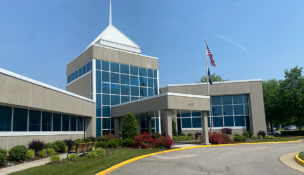HRBT expansion’s first tunnel boring is complete
Tunnel boring machine will begin slow journey to start second tunnel

Mary, the Tunnel Boring Machine, finished the first of two tunnels that are part of the Hampton Roads Bridge-Tunnel expansion. Photo courtesy VDOT.

Mary, the Tunnel Boring Machine, finished the first of two tunnels that are part of the Hampton Roads Bridge-Tunnel expansion. Photo courtesy VDOT.
HRBT expansion’s first tunnel boring is complete
Tunnel boring machine will begin slow journey to start second tunnel
Mary, the tunnel boring machine that has been paving the way for the expanded Hampton Roads Bridge-Tunnel, hit a milestone Wednesday when she finished the first of twin tunnels that are part of the bridge-tunnel’s expansion.
Launched from the HRBT‘s South Island a year ago, the $70 million custom-built tunnel boring machine has been busy — it excavated 7,900 feet, or 750,000 cubic yards of soil, while installing 1,191 concrete rings behind her, according to the Virginia Department of Transportation.
Now, it’s ready to turn around and do it all over again on the return trip to carve out the expansion’s second tunnel. But that turnaround is no easy process. It’s expected to take about six months to turn the tunnel boring machine around and position it for relaunch, when it will begin constructing a parallel tunnel back to the South Island.
About 46 feet in diameter and 430 feet in length, Mary on her busiest day excavated 113 feet of soil and installed 17 rings.
Mary’s work may be in a tunnel, but it’s not in a vacuum.
The $3.9 billion HRBT expansion is the largest highway construction project in Virginia’s history. It’s now expected to be completed by August 2027, about 18 months later than the originally scheduled completion, according to a VDOT news release in late March.
The project consists of widening Interstate 64 between Norfolk and Hampton, including twin two-lane bored tunnels, five new bridges and 20 widened bridges, according to VDOT.
“The Hampton Roads Bridge-Tunnel made history in 1957 as the world’s first tunnel constructed between two man-made islands,” VDOT Commissioner Stephen Brich said in a statement. “Today, the HRBT makes history again as Virginia’s first bored tunnel. With the breakout of the TBM, we are one step closer to the completion of this transformative project that will increase capacity at one of the region’s most congested corridors.”
The tunnel Mary just completed is about 50 feet deeper than the HRBT’s existing tunnels, with the new tunnel’s deepest point plunging 173 feet below the water’s surface. It’s the first tunnel bored in Virginia — the existing ones were constructed using an immersed tube approach, according to VDOT.
“This historic milestone is the culmination of years of transformational transportation congestion relief planning and hard work. Today’s first tunnel breakout is a testament to [the Hampton Roads Transportation Accountability Commission] and VDOT working together to realize a greater vision for Hampton Roads. Once completed, the HRBT and I-64 congestion relief projects financed and delivered through the HRTAC, VDOT, and FHWA [Federal Highway Administration] partnership will enhance the economic vitality and quality of life for the region’s 1.7 million people for generations,” HRTAC Executive Director Kevin Page said in a statement.
-
















